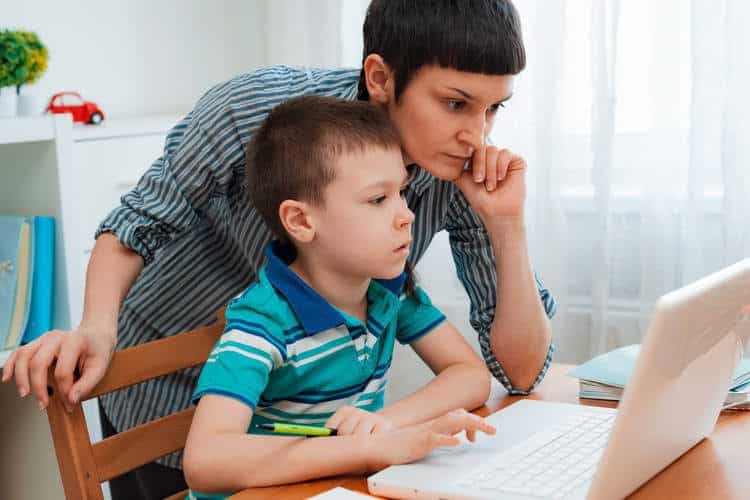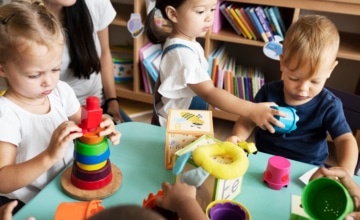Jenny S. Radesky, University of Michigan Medical School

Abstract
Children’s digital media can now be characterized as an environment or space in which children interact with others (e.g., via videochat), learn new concepts (e.g., via educational content), or play and explore (e.g., through games and browsers). As such, it is important for caregivers, researchers, and policymakers to evaluate digital design in order to gauge whether it matches with children’s developmental and relational needs. Conversely, designs that create inequitable access to positive experiences, pressure children to make purchases or view media compulsively, or undermine children’s autonomy to explore their digital and real-world spaces, need to be identified, redesigned, and regulated.
The relationship between children’s digital media use and well-being is complicated. Discussions about children and screen media have been dominated by concepts such as “screen time,” which have lost relevance as parents try to navigate an increasingly technical, mobile, and interactive digital world. Parents no longer are making decisions about which television (TV) programs to let their child watch, but instead have to consider a vast menu of mobile applications (apps) and games, online videos, streaming video platforms, interactive virtual assistants, and Internet-connected toys. Moreover, new products and apps are being introduced so rapidly (e.g., Pokémon GO took 19 days to reach 50 million users!) that research frameworks and policy initiatives have not kept pace. This article presents a novel paradigm for thinking about children’s relationships with modern digital media with the goal of informing a new research agenda, early childhood interventions, and policy priorities.
Deconstructing the Screen Time Paradigm
From a research perspective, screen time is no longer an accurate or comprehensive enough measurement. Screen time was a more relevant concept in the 1980s, when TV or videos were a circumscribed part of a child’s day, delivery of content was unidirectional (not interactive or collecting data on the user’s behavior), and all children had roughly the same options on network or cable TV. When conducting a study, it was far simpler to ask a parent to recall what programs their young child watched on a typical day, compared to going to the home to observe family TV use directly.
Over the past decade and a half, as smartphones and tablet computers have become commonplace, measurement of media use through recall has become much more complicated. Will parents be able to recall how long their child watched online videos, when the child took the tablet to their bedroom? Can parents recall how many times they checked their phone during dinner? Early research has suggested that survey-based parent report is more likely to be inaccurate than not in both instances (Radesky et al., 2020; Yuan et al., 2019). Does the “screen time” concept help describe the interruption of parent–child play by a single call or text message (e.g., Reed et al., 2017) that lasts only a few seconds? Does online learning during the COVID-19 pandemic count as “screen time,” even though it is maintaining a child’s ties to their classroom community? These examples illustrate the problematic nature of a construct that remains prevalent in parenting and lay articles (Bowles, 2020).
Not only has mobility influenced researchers’ ability to accurately measure media’s impact on family well-being, but the interactive design of smartphones, tablets, smart TVs, and virtual assistants means researchers can no longer simply classify media as “educational” or “entertainment.” When the tech industry’s design decisions are largely driven by what can hold users’ attention, persuade them to click through (Fogg, 2009), or collect data to inform marketing profiles (Zuboff, 2019), children’s content needs to be evaluated through a lens that goes beyond TV-relevant constructs. For example, how are children’s viewing habits being influenced by algorithmic recommendations, which contain their own biases (Noble, 2018; Obermeyer et al., 2019)? Do the attention-grabbing design practices in children’s apps help them learn, or distract them (Hirsh-Pasek et al., 2015)? How do targeted nudge techniques and ads interact with brains that haven’t fully developed impulse inhibition? To understand the answers to these questions, it is necessary to think about how children are interacting with digital products shaped by design norms that have taken hold over the past decade of rapid, venture capitalist-driven growth.

Does online learning during the COVID-19 pandemic count as “screen time,” even though it is maintaining a child’s ties to their classroom community? Photo: shutterstock/Juliya Shangarey
Most important to parents, the screen time paradigm also contains key assumptions about who controls children’s media usage. Screen time discussions focusing on when the TV needs to be turned on and off, who picks age-appropriate content, or who leaves the TV on in the background all assume individual responsibility for children’s media use, and could therefore contribute to parent guilt. However, these behaviors may be strongly driven by industry decisions that shape the design of the digital environment. When YouTube announced its goal of reaching 1 billion hours of global viewing per day, business and design decisions went into motion that surely changed the viewing habits of child and parent viewers.
A New Paradigm
Thus, if the focus is on children’s media environments, rather than doses of screens children consume, it becomes much clearer that industry is responsible for designing and maintaining positive, equitable spaces for children—rather than expecting families to individually find ways to navigate a rapidly changing and engagement-driven digital territory. Under this paradigm, several new possibilities for research, intervention, and policy emerge. These hinge around the concept of child-centered design—design that empowers the child and respects children’s need for autonomy, relationships, and nonmedia activities—rather than exploiting the vulnerabilities present at different developmental stages.
The first tenet of child-centered design is that platform developers and content creators need to acknowledge when a child enters their space. Currently, too many app developers label their products as being for “general audiences,” even with titles such as Children’s Doctor Dentist (Zhao et al., 2020). Until September 2019, YouTube did not formally acknowledge that children used its main site ( www.youtube.com, versus their YouTube Kids app), even though some of the most popular videos on the site were clearly child-directed (e.g., nursery rhyme videos; Van Kessel et al., 2019). The inability, or unwillingness, of Internet-based platforms and mobile apps to recognize when children are using their products has led to too many children using age-inappropriate content (Radesky et al., 2020), having private data collected from their devices (Zhao et al., 2020), and technology companies profiting off of child media use as if they were adults.
Another implication of an “environment” paradigm builds on Dr. Tom Frieden’s Health Impact Pyramid (2010). Frieden, a public health expert and former director of the Centers for Disease Control and Prevention, argued that the interventions most likely to make large-scale positive health impact are those that change the context to make default decisions healthier. In contrast, interventions that require individuals to each change their behavior independently are the least likely to make a public health impact. The best-known example of this concept was the New York City Department of Health’s decision in 2005 to ban trans fats from restaurant foods. Trans fats were known to increase cardiovascular risk through changes to people’s cholesterol levels, and they can easily be replaced by other fat sources. Follow-up studies revealed that this widespread change in the food environment in New York—much easier for people to adhere to than, for example, reading nutrition labels at restaurants—led to a 4% decrease in heart disease-related mortality (Restrepo & Rieger, 2016).
Similarly, the individual responsibility for behavior change inherent in a “screen time” paradigm is the least likely to make a meaningful difference in family well-being. In contrast, a systematic attempt to ensure that children’s digital environments are designed with their well-being in mind, which could be accomplished through something as simple as a change in computer code, is much more likely to make an impact. Publicly funded programs such as Mister Rogers Neighborhood and Sesame Street followed a child-centered design ethic, and led to significant benefits for child viewers worldwide (Cole & Lee, 2016; Mares & Pan, 2013).
What would it look like to change children’s modern digital environments to make default decisions healthy? This article outlines several findings that highlight where current digital design is not aligning with child or parent needs and how this misalignment may influence family media use practices. After reviewing what relevance these findings have for clinical work with families of young children, I then discuss implications for policy and design that might allow for a course correction.
Research on the Digital Environment
To understand what a child experiences when entering and exploring the digital environment, my research team and I have developed what we consider a phenomenological approach–in other words, mimicking what a child would experience when they (or their parent) enter different digital spaces. We then combine understanding of the design of these digital spaces with observed behavior in the home or laboratory, intentionally avoiding research questions that solely focus on what the parent needs to do, but rather what the media environment industry needs to do.
For example, when a child enters the app store from their tablet, what is offered to them first? Is it the evidence-based, high-quality media informed by years of developmental psychology and learning science research? We are finding that high-quality programming is not always “rising to the top’” in the expanse of child media content currently available to children. For example, the free app Animal Hair Salon and its various incarnations (e.g., Jungle Animal Hair Salon) have more than 10 million downloads, while the also free and well-researched PBS Kids Scratch Jr. has only 100,000 downloads. If a parent searches for “child educational video” on YouTube, videos such as Cocomelon’s Baa Baa Black Sheep video are offered (with 542,000,000 views as of this writing), as well as toy review videos, but none from Sesame Street. Daniel Tiger’s Neighborhood, a theory-driven program with evidence supporting social–emotional learning (Rasmussen et al., 2016; Rasmussen et al., 2019), has only a fraction of the views (e.g., 195,000 views for the “Daniel Makes a Mistake” episode). Early childhood specialists and home visitors have likely observed that young children commonly view the more popular, and therefore algorithmically promoted, but lower quality entertainment content mentioned previously.
This scenario raises the question: are high-quality media experiences distributed equitably among children, and what role does the design of digital platforms have in this distribution? Are there some media designs that are better suited to support children’s developmental and relational needs, yet others undermine these needs while supporting a profit-driven business model? This article discusses several research methods—albeit a non-exhaustive list, because novel measures are being developed constantly—that have the potential to answer these questions
Assessing the Mobile Device’s Role in Relational Health and Self-Regulation
Mobility was one of the most revolutionary design changes about smartphones and tablets. Parents and children now have handheld computers that adults and children can take to the dinner table, car, bed (or crib!) and use on-demand during any moments of boredom or negative emotion. Mobile devices enter interpersonal spaces and family routines that used to have fewer technological interruptions, and parents report that devices fragment their attention (Radesky, Kistin, et al., 2016). Different from background TV, mobile devices contain many applications that impose more of a cognitive load on parents, such as email, social media, and mobile games. Parents report feeling that their attention is being pulled in multiple directions in ways that feel intrusive (“it’s like it’s the whole world in my lap”) or a relief from their parenting-related boredom and social isolation (Radesky, Kistin, et al., 2016).

The first tenet of child-centered design is that platform developers and content creators need to acknowledge when a child enters their space. Photo: shutterstock/karelnoppe
The impact of mobile design on relational dynamics can be studied through several different approaches, including the following:
- Naturalistic observations: Using field notes or live coding in public settings such as fast food restaurants (Radesky et al., 2014) or playgrounds (Hiniker et al., 2015; Lemish et al., 2020; Wolfers et al, 2020), studies have examined the real-time interactional dynamics that arise when parents used smartphones around their young children. These studies have generally found less parent–child interaction, lower parenting responsiveness or sensitivity, and more missed child bids for attention when parents’ attention is absorbed in mobile phones.
- Lab-based parent–child assessments: Videorecording parent–child dyads in the laboratory setting allows for microcoding of parent–child interactions when parents use smartphones spontaneously during unrelated tasks (Radesky et al., 2015) or when smartphone use is experimentally manipulated to disrupt parent–child interaction (Myruski et al., 2018; Reed et al., 2017). By changing the disrupted task, behavioral coding approach, or linking with other measures, mechanisms of action can be elucidated such as interruption of joint attention or effects on parents’ internal working models of their children (Radesky et al., 2018).

Parents and children now have handheld computers that adults and children can take to the dinner table, car, bed (or crib!) and use on-demand during any moments of boredom or negative emotion. Photo: shutterstock/DoublePHOTO studio
- Questionnaires that assess disruption, rather than duration: The Technology Device Interference Scale developed by McDaniel and Coyne (2016) assesses the construct of “technoference” in daily parent–child activities (see McDaniel, this issue, p. 30). This measure is unique in that it focuses on the role of the device in the relationship rather than the individual; higher technoference scores correlate with parents’ reports of their own compulsive or problematic media use (McDaniel & Radesky, 2018b), as well as higher child externalizing behavior over time (McDaniel & Radesky, 2018a).
- Questionnaires that assess regulatory uses of media: Mobility also means that media can be used more readily during moments of emotional distress, when parents or children might otherwise have used self-regulatory or co-regulatory means of coping. Studies have used 1–2 questions about use of media to calm children when upset or keep them occupied when bored (Radesky, Peacock-Chambers, et al., 2016; Danet et al., 2020), but validated scales are needed to assess this construct and its associations with social–emotional development.
Although mobility is a design feature of the modern digital environment that will not likely recede with design change or regulation, its impact on family interactions might be lessened through several approaches. First, Internet service providers can configure controls that turn off Wi-Fi at certain times of day (e.g., mealtimes, bedtime) as default settings, which would make it easier to preserve interruption-free family routines. Second, mobile apps and Internet platforms could reduce the engagement-prolonging design, described in the next section, that persuades users to view longer, click more, and thereby displace or interrupt family interactions or times of solitude.
Interactive Design: How Modern Media Influences Parent and Child Behavior
Interactivity was the second revolutionary design change in smartphones, tablets, and now smart TVs, smart homes, smart speakers, smart refrigerators, and more (although the word ”smart” is really a marketing moniker; most infants and toddlers are more responsive conversationalists and faster learners than artificial intelligence!).
Interactive design means that users can see one another through videochat, create and post content on social media, and receive recommendations tailored just for them. With the advent of touchscreens, children can now manipulate media through taps and voice commands, and an enormous market has rapidly sprung up around their digital play experiences. Many developers in this market are keen to monetize children’s digital activities through ads, data collection, or in-app purchases, and they have created a class of satisfying, highly engaging apps and videos to which children are drawn, and which rise to the tops of the app stores and algorithms. It is important to research the ways that this explosion of digital products matches or mismatches with children’s developmental needs, as discussed in the following sections.
What Are the Tech Platforms Offering Children First?
As described previously, it is not enough to know what types of high-quality programs will actually support young children’s learning, if those programs are not easily or equitably accessible to children when they enter digital spaces. In my team’s assessment of the top-downloaded or -rated “educational” apps for young children, most apps scored on the lower-quality end based on the Four Pillars of Learning framework (Hirsh-Pasek et al., 2015), and free apps scored worse than paid apps due to having more disruptive ads (Meyer et al., 2020). More research is needed to understand whether highly promoted children’s content in app stores and video streaming services is of lower quality, or lacks essential components such as diverse racial representation.
When Does Interactive Design Support Child Needs, or Undermine Them?
There are certainly many perspectives on children’s developmental needs, and this article does not argue for a “social engineering” in which children must be exposed to restricted, morally driven messages. Rather, children’s needs can be broadly defined in terms of autonomy to play and explore, health and regulatory behaviors such as sleep and social interactions, and exposure to a variety of developmentally appropriate learning materials (both off- and online). A growing body of research has examined the optimal balance of interactive visual and sound effects for supporting children’s reading and comprehension of electronic books (e.g., Takacs et al., 2015) or solving learning tasks (e.g,. Choi & Kirkorian, 2016). Researchers have also examined the larger social context within which learning occurs, finding that interactive enhancements in ebooks can lead to less social reciprocity and verbal interaction between parents and toddlers (Munzer et al., 2019a, 2019b). More research is needed to examine whether engagement-promoting design (e.g., notifications, tokens for prolonged play, daily gifts and rewards) lead to more parent or child media use that interferes with healthy everyday behaviors and interactions.
Where Are Adult Design Principles Being Used Inappropriately With Children?
Textbooks have been written about how to design habit-forming products (Eyal, 2014) that reduce users’ cognitive controls while interacting with digital spaces (Krug, 2000). Although these “frictionless” design approaches have been effective in nudging adult users toward purchases or engagement with digital products, they may be manipulative when applied to children with fewer impulse inhibition or critical thinking skills. For example, if children are provided daily rewards for engaging with a mobile app—a known metric of app “success”—it is important to understand how this displaces other activities or leads to family conflict, such as more child tantrums (Munzer et al., 2020). If design techniques are intended to induce habits or compulsive use, it is important for designers to understand when these “sticky” design techniques have crossed a line and are no longer letting the child play autonomously. In contrast, Fred Rogers took painstaking time to write his scripts so that he wouldn’t inadvertently mislead children. Rather than encourage more engagement, characters like Curious George and Fig the Fox from Tumbleleaf encourage children to turn off the program and apply their newly gained knowledge to the world around them.
When Has Monetization Gone too Far?
The adult digital environment has largely been built upon a business model of targeted advertising that makes money for both the big platforms and for the apps or content creators that advertise. Is this system appropriate for kids? While it is reasonable to pay for a well-designed app, or upgrade to a paid app once it has been downloaded for free to try it out, many apps go way farther than this in extracting profits from child play. In my team’s analysis of the top-downloaded apps in the “5 & Under” category of Google Play, we found apps that included pop-up ad videos every few minutes, age-inappropriate ads, ads disguised as sparkling presents or cakes meant to get children to click on them, and characters who encouraged children to make in-app purchases (Meyer et al., 2019). We also found that two thirds of apps played by 3–4-year-old children contained data trackers that sent private data to third party companies (usually advertising networks or Facebook; Zhao et al., 2020). Although this is a common, although ethically questionable, practice in design for adults, it is not legal under the Child Online Privacy Protection Act (COPPA, 1998) without verifiable adult consent. More studies are needed to understand what types of child-inappropriate design practices are occurring in their digital spaces–kind of like the “trans fats” of children’s media–so they can be eliminated.
How Does Design Potentially Propagate Socioeconomic and Racial Disparities?
The digital environment may act as a new source of structural inequality for young children if disparities in access to quality content are not addressed. Avoiding this inequality may mean ensuring that children from low-income families have access to high-quality educational content through continued support of the Public Broadcasting Service, collaboration between early childhood media platforms and community programs such

The digital environment may act as a new source of structural inequality for young children if disparities in access to quality content are not addressed. Photo: shutterstock/Zorro Stock Images
as Head Start, or income-related discounts (as were seen for Internet access during COVID-19). More research is needed on whether algorithms unevenly recommend different content to children of different races and ethnicities, promote videos or apps with more White characters, or target health-related misinformation to parents from minority race/ethnicity.
Implications for Clinical Interventions
As noted previously, it is important not to lay the expectation on parents that they are solely responsible for managing their child’s media use. Instead, professionals need to support parents in knowing more about interactive design, how they and their child respond to it, and whether it supports or undermines them as a parent. Professionals should help them set up a digital environment for themselves and their child that feels balanced and enriching, not compulsive or stress-inducing. For example, instead of talking about how much “screen time” a child gets, early childhood interventionists can use approaches in Table 1.
Table 1. Family-Centered Approaches for Discussing the Digital Environment
Use the following suggestions and questions to help parents think about their digital environment:
Discuss media use in the context of daily routines: Encourage parents to think about their day. Ask: Where does mobile media come in, and did you plan it that way, or did it just happen without much conscious thought? Did engagement-promoting design (e.g., likes, rewards) contribute to that unconscious habit?
Help parents reflect on media’s effect on them: Ask: What types of media stress you out and make it harder to multitask between your phone and your child? What types of media use are most supportive and helpful? If you jumped down a rabbit hole on social media or spent too much time binge-watching, how did it make you feel? What did you miss out on in real life?
Do some experimenting: It’s easy to uninstall apps that parents identify as time-wasters or stress-inducers. Between weekly visits, challenge parents to uninstall apps such as social media, news, or mobile games, and see how they feel a week later.
Encourage time for single-tasking: Parents have never had their attention pulled in so many directions at once. They might feel relieved to create unplugged spaces in their homes or times of day (e.g., through Wi-Fi-shutoffs).
Find replacement strategies for regulatory uses of media: Nothing quiets a child down like a phone. However, this type of use doesn’t let the child learn internal self-regulation strategies. Interventionists should recognize that affect regulation may be a strong driver of child media use, and they will need to work with parents on other ways to tolerate or help their child through big emotions.
Build savviness about how digital platforms make profits and collect/ share data: Unfortunately, most platforms and apps are not very transparent about how users help them make money. When it comes to finding quality children’s media, parents can read reviews on a free resource such as Common Sense Media or see suggestions on their website created during COVID-19, www.wideopenschool.com.
Conclusion: A Healthy-by-Default Digital Environment
Children’s digital environments are far from the “neighborhood expression of care” Fred Rogers envisioned for children’s media. While waiting for research to produce more evidence about how digital design can either support or undermine families’ needs, committed child-centered designers and platforms can take action now to create a healthy-by-default digital environment.
The ideas proposed in this article are by no means exhaustive, but they represent needs based on research that has been conducted to date, as well as aspirational goals based on the challenges children are facing during a pandemic, school closures, racial injustice, economic inequality, and political instability. First and foremost, digital designers need to recognize that their design choices shape the lenses through which children see the digital environment, and any biases inherent in those lenses can lead to inequities. Children need platforms that wholly embrace the fact that they are visited by children, that contain vetted content with algorithms (if they exist) that elevate products of the highest quality. Children deserve to be given the choice to search for what they want, not follow what is fed to them, and to have equitable access to high-quality content with minimal advertising or monetization, and no data tracking. Even better, a focus on content that promotes empathy, mind-mindedness, and humility; tolerance of solitude and uncertainty; educational challenges and opportunities that transfer to offline and social spaces; and parents’ ability not to feel tied to their devices, either.
Federal policies do not yet exist to demand such changes in children’s digital spaces. However, early childhood organizations and clinicians can support legislation that aims to remove manipulative or engagement-prolonging design (e.g., KIDS Act, 2020), or data collection about children’s online behaviors (e.g., Do Not Track Kids Act, 2018). ZERO TO THREE can be an important advocate in this arena, given its expertise in early brain development, relationships, and inequities in health and opportunities.
Nonprofit organizations such as PBS KIDS, Sesame Workshop, and Common Sense Media can continue to provide content and guidance for families, but larger platforms will need to do their part in recognizing their child audiences and elevating positive content. Although some industry self-regulation has occurred over the past few years, including changes to YouTube and Google Play in 2019 to reduce data collection from child viewers, more needs to be done, which will likely occur only with collective and sustained consumer pressure.
This computer in parents’ pockets changed life forever. They take it everywhere, and it interacts with their psychology and that of their children. Families therefore need new research approaches, interventions, and policies that reflect the complexity of this new force in their lives.
Learn More
Helping parents improve their family’s relationship with technology: www.humanetech.com/families-educators
How parents can learn more about good child-centered interactive design: www.zerotothree.org/resources/2533-choosing-mediacontent-for-young-children-using-the-e-aims-model
Helpful information about digital privacy and children: www.childrenscommissioner.gov.uk/digital/who-knows-what-about-me
More information about child-centered design regulations: https://5rightsfoundation.com/uploads/demystifying-the-age-appropriate-design-code.pdf
Website for Dr. Radesky’s lab: https://radesky.lab.medicine.umich.edu/home
Suggested Citation
Radesky, J. S. (2020). Advocating for a child-centered digital environment. ZERO TO THREE Journal, 41(2), 5–12.
Author Bio
Jenny S. Radesky, MD, is a developmental behavioral pediatrician and assistant professor of pediatrics at the University of Michigan Medical School. She received her medical degree from Harvard Medical School, trained at Seattle Children’s Hospital and Boston Medical Center, and her clinical work focuses on developmental and behavioral conditions in low-income and underserved populations. Her National Institutes of Health–funded research focuses on the use of mobile/ interactive technology by parents and young children and how this use relates to child self-regulation and parent–child interaction. Dr. Radesky was the lead author of the American Academy of Pediatrics policy statements Media and Young Minds in 2016 and Digital Advertising to Children in 2020.
Twitter: @jennyradesky
References
Bowles, N. (2020, March 31). Coronavirus ended the screen time debate. Screens won. The New York Times. link
Children’s Online Privacy Protection Act (COPPA) of 1998, 15 U.S.C. 6501-6505. link
Choi, K., & Kirkorian, H. L. (2016). Touch or watch to learn? Toddlers’ object retrieval using contingent and noncontingent video. Psychological science, 27(5), 726–736.
Cole, C. F., & Lee, J. H. (Eds.). (2016). The Sesame effect: The global impact of the longest street in the world. Routledge.
Danet, M., Miller, A. L., Weeks, H. M., Kaciroti, N., & Radesky, J. R. (2020). Inhibitory control and mobile media use in preschool-aged children [Manuscript in preparation].
Do Not Track Kids Act of 2018, S.2932. www.congress.gov/bill/115thcongress/senate-bill/2932
Eyal, N. (2014). Hooked: How to build habit-forming products. Penguin.
Fogg, B. J. (2009, April). A behavior model for persuasive design. Proceedings of the 4th International Conference on Persuasive Technology, 1–7.
Frieden, T. R. (2010). A framework for public health action: The health impact pyramid. American Journal of Public Health, 100(4), 590–595.
Hiniker, A., Sobel, K., Suh, H., Sung, Y. C., Lee, C. P., & Kientz, J. A. (2015, April). Texting while parenting: How adults use mobile phones while caring for children at the playground. Proceedings of the 33rd Annual ACM Conference on Human Factors in Computing Systems, 727–736.
Hirsh-Pasek, K., Zosh, J. M., Golinkoff, R. M., Gray, J. H., Robb, M. B., & Kaufman, J. (2015). Putting education in “educational” apps: Lessons from the science of learning. Psychological Science in the Public Interest, 16(1), 3–34.
Kids Internet Design Safety (KIDS) Act, S.3411. link
Krug, S. (2000). Don’t make me think!: A common sense approach to Web usability. Pearson Education India.
Lemish, D., Elias, N., & Floegel, D. (2020). “Look at me!” Parental use of mobile phones at the playground. Mobile Media & Communication, 8(2), 170–187.
Mares, M. L., & Pan, Z. (2013). Effects of Sesame Street: A meta-analysis of children’s learning in 15 countries. Journal of Applied Developmental Psychology, 34(3), 140–151.
McDaniel, B. T., (2020). Technoference: Parent mobile device use and implications for children and parent–child relationships. ZERO TO THREE Journal, 41(2), 30–36.
McDaniel, B. T., & Coyne, S. M. (2016). “Technoference”: The interference of technology in couple relationships and implications for women’s personal and relational well-being. Psychology of Popular Media Culture, 5(1), 85–98.
McDaniel, B. T., & Radesky, J. S. (2018a). Technoference: Longitudinal associations between parent technology use, parenting stress, and child behavior problems. Pediatric Research, 84(2), 210–218.
McDaniel, B. T., & Radesky, J. S. (2018b). Technoference: Parent distraction with technology and associations with child behavior problems. Child Development, 89(1), 100–109.
Meyer, M., Adkins, V., Yuan, N., Weeks, H. M., Chang, Y. J., & Radesky, J. (2019). Advertising in young children’s apps: A content analysis. Journal of Developmental & Behavioral Pediatrics, 40(1), 32–39.
Meyer, M., Zosh, J., McLaren, C., McCafferty, H., Robb, M., Golinkoff, R., HirshPasek, K., & Radesky, J. (2020). How educational are “educational” apps for young children? App store content analysis using the Four Pillars of Learning framework [Manuscript under revision].
Munzer, T. G., Miller, A. L., Weeks, H. M., Kaciroti, N., & Radesky, J. (2019a). Differences in parent-toddler interactions with electronic versus print books. Pediatrics, 143(4), e20182012. DOI: https://doi.org/10.1542/peds.2018-2012
Munzer, T. G., Miller, A. L., Weeks, H. M., Kaciroti, N., & Radesky, J. (2019b). Parent-toddler social reciprocity during reading from electronic tablets vs print books. JAMA Pediatrics, 173(11), 1076–1083.
Munzer, T. G., Miller, A. L., Wang, Y., Kaciroti, N., & Radesky, J. S. (2020). Tablets, toddlers and tantrums: The immediate effects of tablet device play. Acta Paediatrica. https://doi.org/10.1111/apa.15509 or https://onlinelibrary.wiley.com/doi/abs/10.1111/apa.15509
Myruski, S., Gulyayeva, O., Birk, S., Pérez-Edgar, K., Buss, K. A., & Dennis-Tiwary, T. A. (2018). Digital disruption? Maternal mobile device use is related to infant social-emotional functioning. Developmental Science, 21(4), e12610.
Noble, S. U. (2018). Algorithms of oppression: How search engines reinforce racism. NYU Press.
Obermeyer, Z., Powers, B., Vogeli, C., & Mullainathan, S. (2019). Dissecting racial bias in an algorithm used to manage the health of populations. Science, 366(6464), 447–453.
Radesky, J., Leung, C., Appugliese, D., Miller, A. L., Lumeng, J. C., & Rosenblum, K. L. (2018). Maternal mental representations of the child and mobile phone use during parent-child mealtimes. Journal of Developmental and Behavioral Pediatrics: JDBP, 39(4), 310–317.
Radesky, J., Miller, A. L., Rosenblum, K. L., Appugliese, D., Kaciroti, N., & Lumeng, J. C. (2015). Maternal mobile device use during a structured parent–child interaction task. Academic Pediatrics, 15(2), 238–244.
Radesky, J. S., Kistin, C., Eisenberg, S., Gross, J., Block, G., Zuckerman, B., & Silverstein, M. (2016). Parent perspectives on their mobile technology use: The excitement and exhaustion of parenting while connected. Journal of Developmental & Behavioral Pediatrics, 37(9), 694–701.
Radesky, J. S., Kistin, C. J., Zuckerman, B., Nitzberg, K., Gross, J., KaplanSanoff, M., … & Silverstein, M. (2014). Patterns of mobile device use by caregivers and children during meals in fast food restaurants. Pediatrics, 133(4), e843–e849.
Radesky, J. S., Peacock-Chambers, E., Zuckerman, B., & Silverstein, M. (2016). Use of mobile technology to calm upset children: Associations with socialemotional development. JAMA Pediatrics, 170(4), 397–399.
Radesky, J. S., Weeks, H. M., Ball, R., Schaller, A., Yeo, S., Durnez, J., … & Barr, R. (2020). Young children’s use of smartphones and tablets. Pediatrics, 146,(1), e20193518 DOI: https://doi.org/10.1542/peds.2019-3518
Rasmussen, E. E., Shafer, A., Colwell, M. J., White, S., Punyanunt-Carter, N., Densley, R. L., & Wright, H. (2016). Relation between active mediation, exposure to Daniel Tiger’s Neighborhood, and US preschoolers’ social and emotional development. Journal of Children and Media, 10(4), 443–461.
Rasmussen, E. E., Strouse, G. A., Colwell, M. J., Russo Johnson, C., Holiday, S., Brady, K., … & Norman, M. S. (2019). Promoting preschoolers’ emotional competence through prosocial TV and mobile app use. Media Psychology, 22(1), 1–22.
Reed, J., Hirsh-Pasek, K., & Golinkoff, R. M. (2017). Learning on hold: Cell phones sidetrack parent-child interactions. Developmental Psychology, 53(8), 1428–1436.
Restrepo, B. J., & Rieger, M. (2016). Trans fat and cardiovascular disease mortality: Evidence from bans in restaurants in New York. Journal of Health Economics, 45, 176–196.
Takacs, Z. K., Swart, E. K., & Bus, A. G. (2015). Benefits and pitfalls of multimedia and interactive features in technology-enhanced storybooks: A meta-analysis. Review of Educational Research, 85(4), 698–739.
Van Kessel, P. V., Toor, S., & Smith, A. (2019). A week in the life of popular YouTube channels. Pew Research Center. link
Wolfers, L. N., Kitzmann, S., Sauer, S., & Sommer, N. (2020). Phone use while parenting: An observational study to assess the association of maternal sensitivity and smartphone use in a playground setting. Computers in Human Behavior, 102, 31–38.
Yuan, N., Weeks, H. M., Ball, R., Newman, M. W., Chang, Y. J., & Radesky, J. S. (2019). How much do parents actually use their smartphones? Pilot study comparing self-report to passive sensing. Pediatric Research, 86(4), 416–418.
Zhao, F., Egelman, S., Weeks, H. M., Kaciroti, N., Miller, A. L., & Radesky, J. S. (2020). Data collection practices of mobile applications played by preschool-aged children. JAMA Pediatrics, e203345–e203345.
Zuboff, S. (2019). The age of surveillance capitalism: The fight for a human future at the new frontier of power: Barack Obama’s books of 2019. Profile Books.



